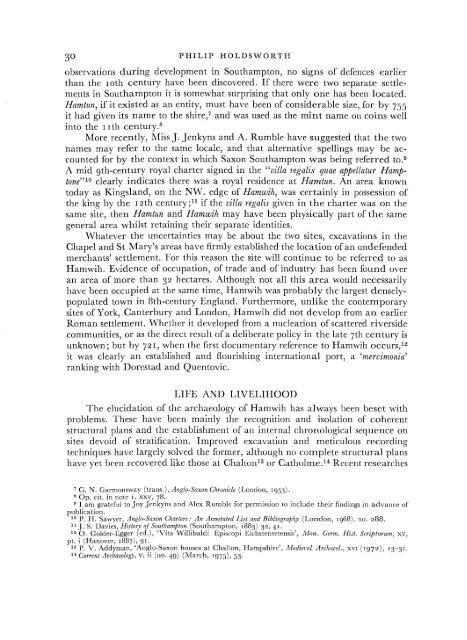Saxon Southampton; a New Review - Archaeology Data Service
Saxon Southampton; a New Review - Archaeology Data Service
Saxon Southampton; a New Review - Archaeology Data Service
You also want an ePaper? Increase the reach of your titles
YUMPU automatically turns print PDFs into web optimized ePapers that Google loves.
PHILIP HOLDSWORTH<br />
observations during development in <strong>Southampton</strong>, no signs of defences earlier<br />
than the loth century have been discovered. If there were two separate settlements<br />
in <strong>Southampton</strong> it is somewhat surprising that only one has been located.<br />
Hamtun, if it existed as an entity, must have been of considerable size, for by 755<br />
it had given its name to the shire," and was used as the mint name on coins well<br />
into the r rth ceritury."<br />
More recently, Miss J. ]enkyns and A. Rumble have suggested that the two<br />
names may refer to the same locale, and that alternative spellings may be accounted<br />
for by the context in which <strong>Saxon</strong> <strong>Southampton</strong> was being referred to."<br />
A mid 9th-century royal charter signed in the "villa regalis quae appellatur Hamptone"10<br />
clearly indicates there was a royal residence at Hamtun. An area known<br />
today as Kingsland, on the NW. edge of Hamwih, was certainly in possession of<br />
the king by the r zth century;"! if the villa regalis given in the charter was on the<br />
same site, then Hamtun and Hamwih may have been physically part of the same<br />
general area whilst retaining their separate identities.<br />
Whatever the uncertainties may be about the two sites, excavations in the<br />
Chapel and St Mary's areas have firmly established the location ofan undefended<br />
merchants' settlement. For this reason the site will continue to be referred to as<br />
Hamwih. Evidence of occupation, of trade and of industry has been found over<br />
an area of more than 32 hectares. Although not all this area would necessarily<br />
have been occupied at the same time, Hamwih was probably the largest denselypopulated<br />
town in 8th-century England. Furthermore, unlike the contemporary<br />
sites of York, Canterbury and London, Hamwih did not develop from an earlier<br />
Roman settlement. Whether it developed from a nucleation of scattered riverside<br />
communities, or as the direct result of a deliberate policy in the late 7th century is<br />
unknown; but by 721, when the first documentary reference to Hamwih occurs.l''<br />
it was clearly an established and flourishing international port, a 'mercimonia'<br />
ranking with Dorestad and Quentovic.<br />
LIFE AND LIVELIHOOD<br />
The elucidation of the archaeology of Hamwih has always been beset with<br />
problems. These have been mainly the recognition and isolation of coherent<br />
structural plans and the establishment of an internal chronological sequence on<br />
sites devoid of stratification. Improved excavation and meticulous recording<br />
techniques have largely solved the former, although no complete structural plans<br />
have yet been recovered like those at Chalton 13 or Catholme.P Recent researches<br />
7 G. N. Garmonsway (trans.), Anglo-<strong>Saxon</strong> Chronicle (London, 1953).<br />
8 Op. cit. in note I, xxv, 78.<br />
9 I am grateful to Joy Jenkyns and Alex Rumble for permission to include their findings in advance of<br />
publication.<br />
10 P. H. Sawyer, Anglo-<strong>Saxon</strong> Charters: An Annotated List and Bibliography (London, 1968), no. 288.<br />
11 J. S. Davies, History of<strong>Southampton</strong> (<strong>Southampton</strong>, 1883) 32,41.<br />
12 O. Golder-Egger (ed.), 'Vita Willibaldi Episcopi Eichstentetensis', Mon. Germ. Hist. Scriptorum, xv,<br />
pt. i (Hanover, 1887),91.<br />
13 P. V. Addyman, 'Anglo-<strong>Saxon</strong> houses at Chalton, Hampshire', Medieval Archaeol., XVI (1972), 13-31.<br />
I< Current <strong>Archaeology</strong>, v, ii (no. 49) (March, 1975),53.

















